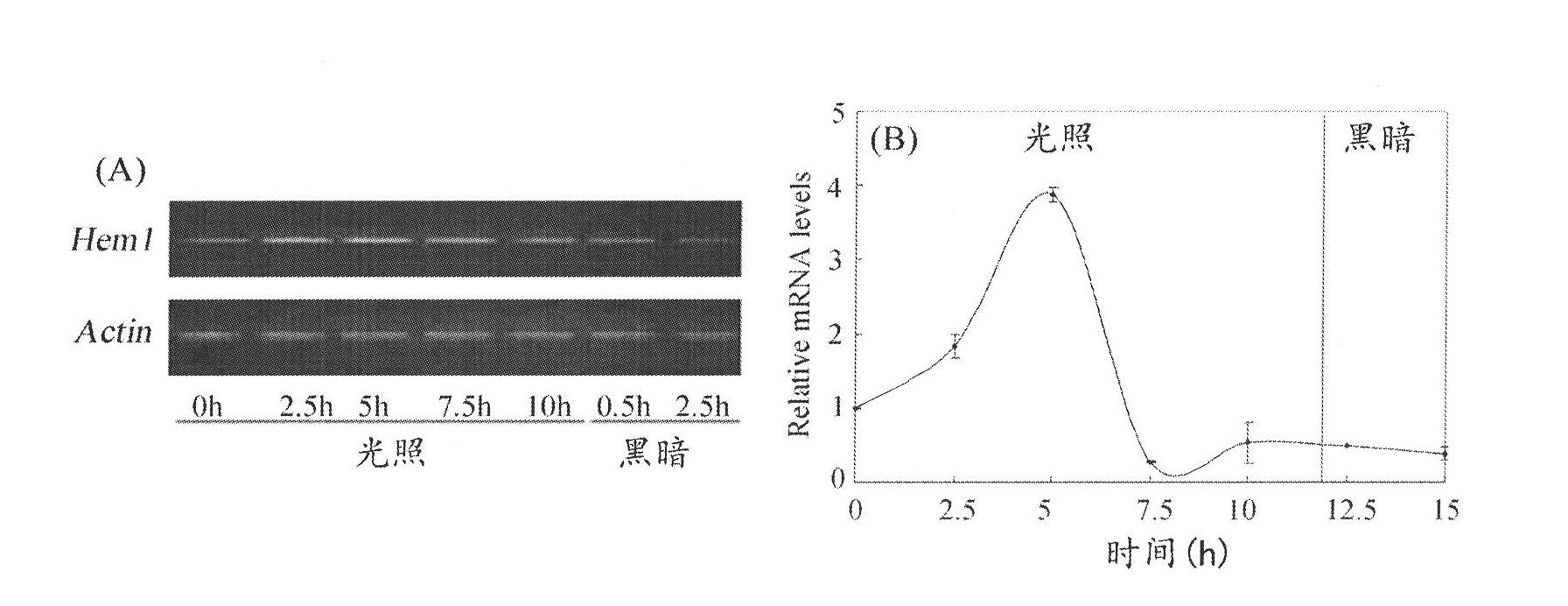Transgenic method capable of controlling ALA synthesis in plants and promoting growth and stress resistance
A technology for promoting growth and stress resistance, applied in the field of genetic engineering, can solve the problems of no practical value, photobleaching of transgenic plants, etc., and achieve the effects of increased biological yield and economic yield, normal growth and development, and strong stress resistance.
- Summary
- Abstract
- Description
- Claims
- Application Information
AI Technical Summary
Problems solved by technology
Method used
Image
Examples
Embodiment 1
[0032] Embodiment 1, the acquisition of transphotosensitive promoter AtHemA1P and YHem1 plants
[0033] 1. Construction of the recombinant expression vector used for the transgene
[0034] 1. Acquisition of Arabidopsis HemA1 photosensitive promoter (AtHemA1P)
[0035] According to the nucleotide sequence of the Arabidopsis thaliana HemA1 gene promoter registered in Genbank (Genebank No: AF295364), the total DNA of the extracted Arabidopsis thaliana was used as a template, and the primer (AtHemA1PZ1: 5 '-CCCAAGCTTACCGAAATGTAGGAATCCCACTTC-3' and primers (AtHemA1PF1: 5'-AGGATCCCAAAATCTCAATCTCCTCTCTGTC-3') added with BamHI restriction sites were used for PCR amplification. The amplification system was 50μl, containing 10mmol / L Tri-HCl pH 8.3, 50mmol·L -1 KCl, 2mmol L -1 Mg 2 Cl, 250 μmol L -1 Various dNTPs, 25pmol of each primer, 200-500ng of DNA, and 1U of Taq polymerase, the amplification conditions were 94°C / 10min pre-denaturation, 94°C / 40s denaturation, 72°C annealing and ...
example 1
[0077] Example 1, the functional identification of the light-sensitive promoter AtHemA1P controlling the YHem1 gene in tobacco
[0078] 1. Changes of YHem1 gene expression in transgenic tobacco with light time
[0079] In order to detect the light-sensitive promoter AtHemA1P controlling the expression of YHem1 gene under light, the T cells transfected with YF8631 3 In the next generation tobacco plants, the expression of YHem1 gene was detected by semi-quantitative and real-time fluorescent quantitative PCR with the change of light time.
[0080] The result is as figure 2 As shown, whether semi-quantitative PCR detection or real-time fluorescence quantitative PCR detection was used, the expression of YHem1 gene increased rapidly when the transgenic tobacco was changed from dark conditions to light conditions, reached the maximum value after 5 hours of light, and then gradually decreased. After 2.5 hours in the dark, the transcription level of YHem1 gene was very low, indica...
example 2
[0106] Example 2, functional identification of YHem1 Arabidopsis controlled by the photosensitive promoter AtHemA1P
[0107] 1. Study on improving salt tolerance of transgenic Arabidopsis
[0108] The independent T of the positive transgenic Arabidopsis that example 1 obtains 2 generation strain (P 0 , P 3 , P 12 ) seeds are sterilized (carried out according to the method of step 2 in method two in example 1), and the transgenic Arabidopsis T thaliana after disinfection 2 Generation (P 0 , P 3 , P 12 ) seeds were spread on MS medium containing 0, 50mM, 100mM, 150mM NaCl, cultured in the dark at 4°C for two days, then transferred to 22±2°C, cultured in 16hr light, and grown under salt stress for two weeks, and observed, cultured under the same conditions Wild type Arabidopsis (WT) (WT Arabidopsis, 'Columbia' ecotype) was used as a control.
[0109] It was found that the growth of the transformed YK3840-YHem1 Arabidopsis lines and wild-type Arabidopsis (WT) was inhibited...
PUM
 Login to View More
Login to View More Abstract
Description
Claims
Application Information
 Login to View More
Login to View More - R&D
- Intellectual Property
- Life Sciences
- Materials
- Tech Scout
- Unparalleled Data Quality
- Higher Quality Content
- 60% Fewer Hallucinations
Browse by: Latest US Patents, China's latest patents, Technical Efficacy Thesaurus, Application Domain, Technology Topic, Popular Technical Reports.
© 2025 PatSnap. All rights reserved.Legal|Privacy policy|Modern Slavery Act Transparency Statement|Sitemap|About US| Contact US: help@patsnap.com



